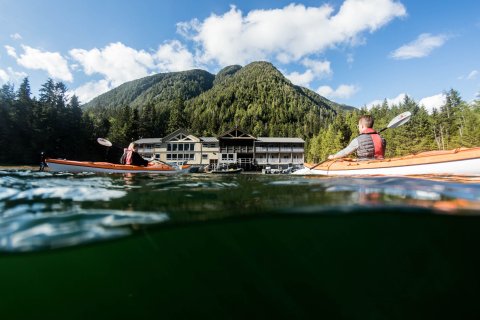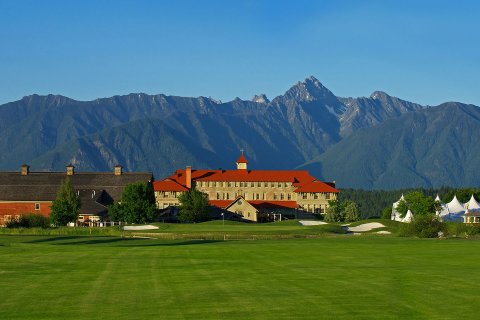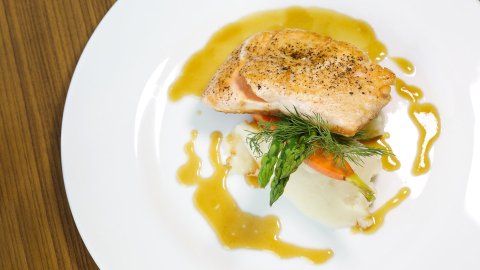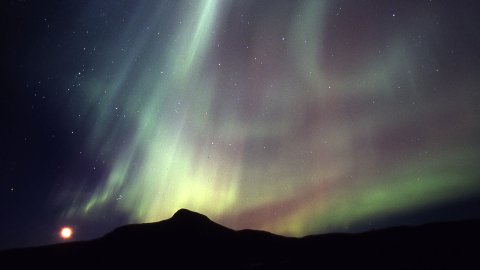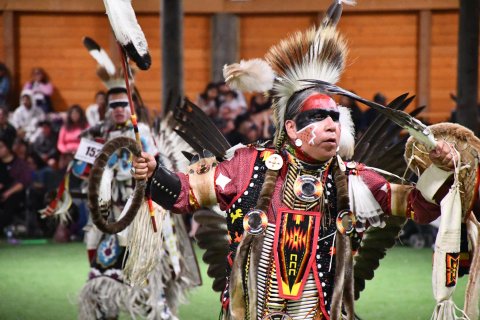The Important Role Indigenous Tourism Plays in Reconciliation

Standing on the grassy riverside trail leading to the 2000-year-old winter village at the Secwepemc Museum and Heritage Park, it’s hard to ignore the red brick Kamloops Indian Residential School looming nearby. In a few months this will become the location of the first shattering announcement about unmarked gravesites that will plunge our country into mourning. But for now, it’s a peaceful setting where visitors can learn about the rich history and culture of the Secwepemc People who lived upon these traditional and unceded lands for thousands of years.
Showing us various edible and medicinal plants found in the arid region, our guide Greg Hopf of Moccasin Trails explains how the Secwepemc People were able thrive—building comfortable pit homes for winter, while processing a wide range of plants and animals to keep the community well fed. In the past, this is the point where Indigenous-focused tourism might have ended—firmly stuck in historical times—leaving visitors with the idea that this pre-contact era is when Indigenous culture stopped evolving. Instead, our tour carried on, and soon we were inside the museum, learning about the horrors endured in that nearby red brick building.
While it can sound like a heavy theme for a tourism experience, modern Indigenous Tourism options like Wikwemikong Tourism in Ontario and Moccasin Trails and Secwepemc Museum and Heritage Park in British Columbia’s interior don’t stop their stories at contact. Instead, they do a deep dive into what came next. “Visitors learn about our land, animals, songs, stories and food—and our challenges. In doing so they learn about themselves,” says Hopf, as he goes on to explain the importance of sharing the entire story, “This is how tourism can become an act of reconciliation.”
Defined as a way to establish and maintain respectful relationships between Indigenous and non-Indigenous peoples—reconciliation through tourism can be one of the most meaningful actions we can take. While it’s harrowing to discover the impacts of residential schools and racist policies, relearning history can open our minds and hearts, and offer a new perspective. Along the way it also gives us a chance to forge a deeper connection to the lands, traditions and ways of life of Indigenous Peoples, while offering a better understanding of the history of Canada.
Take a step on the path to reconciliation:

Develop an awareness of the past: With Wikwemikong Tourism in Point Grondine Park, visitors have the opportunity to learn Anishnaabek teachings and discover the pride that grows when communities reclaim and share their traditional culture and wisdom with visitors. Explore the diverse wetlands and woodlands of the Niagara Escarpment with a traditional Knowledge Keeper and learn skills like plant based medicine, Indigenous wayfinding and astronomy, deer skinning and tanning, trapping, archery or shoreline fishing.
Understand the harm that’s been inflicted: On the bountiful banks of the South Thompson River at Secwepemc Museum and Heritage Park (near the site where 215 unmarked graves were identified) you’ll learn about the abuse Indigenous People underwent in residential schools and about the healing many communities are engaged in. You’ll also develop an awareness of the strength and resilience that are found through traditional cultural teachings and ways of being.
Make a commitment to change: Knowledge Keepers with Moccasin Trails will guide you through the past and into the future with stories and ceremonies that offer a glimpse into how much stronger we can be when we walk together. Visitors will learn how tourism is providing the Secwepemc and Syilx Peoples with confidence, economic security, and marketable skills as they develop restaurants, award-winning wineries and world-class cultural centres that reflect their traditional knowledge and teachings.
Reconciliation isn’t a box to be ticked, but a process—and Indigenous-led tourism offers a welcoming step along the path.
Featured Experiences

St. Eugene Golf Resort & Casino
Cranbrook, British Columbia Accommodation & Relaxation, Culture & Heritage, Reconciliation


